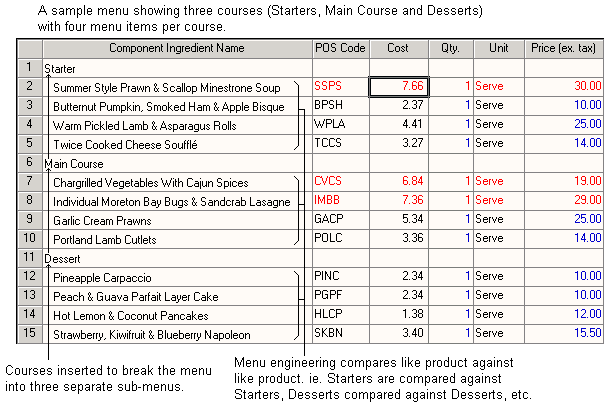Menu Engineering is a mathematical model for analyzing the relative sales/profit earning potential of the individual items on a menu which helps you to focus on actual profit returned from a menu, rather than the usual focus on the percentage cost of menu items.
It's all relative
The key word in menu engineering is 'relative'. Menu engineering compares each menu item against it's peers on the menu. In fact, for menu engineering to work properly, you need to compare like products against like products. That is, desserts should be compared against other desserts and main courses should only be compared against main courses, etc.
In order to accomplish this, Resort Restaurant gives you the ability to break a menu into sub-menus by the insertion of 'courses' into the menu list. You insert the courses to indicate the sub-menus (i.e. starters, main courses, desserts, etc) and, for menu engineering calculation purposes, the program treats each sub-menu as an isolated unit.
The screen shot below shows a very simple menu which consists of three courses ('Starter', 'Main Course', and 'Desserts') where each course has four different dishes assigned to it.

You enter a budget or actual sales quantity for each item on the menu and Resort Restaurant uses these figures, along with the previously calculated recipe costs, to perform the menu engineering calculations. These calculations determine the relative popularity for each item (called the Menu Mix, or MM for short) and the relative gross profit return for each item (called the Contribution Margin, or CM for short). The MMs and CMs for each menu item are then compared to each other to determine an overall ranking for each item on the sub-menu.
These rankings are one of four standard rankings based on that item's sales performance/price combination. The program uses the standard menu rankings of Dog, Puzzle, Plough Horse and Star to show you the relative performance of each item in a menu. These rankings are discussed in detail below.

•Star. Menu Mix Rank: High, Contribution Margin Rank: High. These items are literally your 'star' performers. They sell well (MM Rank = High), and they return a good profit (CM Rank = High). Menu items with this ranking should not be tampered with too much. A 'Star' ranking for a menu item indicates that you have hit the 'sweet spot' between popularity and price for that particular item. Any price increases might meet buyer resistance and lower the total unit sales, reducing the MM Rank.
•Puzzle. Menu Mix Rank: Low, Contribution Margin Rank: High. These menu items don't sell in particularly large quantities (MM Rank = low), but they do make a relatively high profit (CM Rank = High). It may, in some cases, be feasible to promote these items up to a 'Star' ranking by adjusting their prices downwards slightly. This price reduction could lead to more unit sales and hence bump the MM Rank up to 'High' without losing the high CM ranking. You will need to use your experience and intuition when experimenting with these prices.
•Plough Horse. Menu Mix Rank: High, Contribution Margin Rank: Low. These menu items are your steady sellers (MM Rank = High), but unfortunately, you won't make your fortune from them (CM Rank = Low). Minor price increases for these items may improve their profitability and Contribution Margin ranking, but this may also have the effect of reducing their total sales and reducing the MM Rank. These items are worth experimenting with price and/or portion size in an attempt to improve their profitability, but preferably not at the expense of their popularity.
•Dog. Menu Mix Rank: Low, Contribution Margin Rank: Low. These menu items are particularly poor performers. They don't sell well (MM Rank = Low), and they don't make much profit relative to their peers (CM Rank = Low). Any menu items with this ranking should be considered for deletion from the menu. You may find that increasing the price of one of these items might push it up one ranking by increasing it's CM Rank, but unfortunately, this will tend to make the item's sales quantity, and hence, its Menu Mix even worse.
NOTE: When we say a menu item doesn't make much profit, what is meant is that compared to the other items in the sub-menu, the item has a relatively low profit.
See the topic titled 'How can I make Menu Engineering work for me?' for details on using Resort Restaurant's menu engineering facilities.